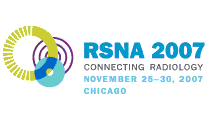
Abstract Archives of the RSNA, 2007
SST04-08
Duplex Doppler Sonography: The Clinical Relevance of Elevated Renal Vein Velocity in Kidney Transplants
Scientific Papers
Presented on November 30, 2007
Presented as part of SST04: Genitourinary (Ultrasound)
Michael Younghyeuk Im BS, Presenter: Nothing to Disclose
Suzanne Palmer MD, Abstract Co-Author: Nothing to Disclose
Hossein Jadvar MD, PhD, Abstract Co-Author: Nothing to Disclose
Yasir Qazi MD, Abstract Co-Author: Nothing to Disclose
Pankaj Bahl MD, Abstract Co-Author: Nothing to Disclose
Edward Gary Grant MD, Abstract Co-Author: Nothing to Disclose
To determine the relationship between clinical outcome and elevated velocity in the main renal vein (MRV) of kidney transplants as determined by duplex Doppler sonography.
331 consecutive color/duplex Doppler ultrasounds in 170 patients were retrospectively reviewed and maximum velocity in the MRV recorded. MRV velocity was then correlated with clinical outcome based on results of renal biopsy (n=56), angiography (n=2), and GFR at 6 and 12 months post operatively (n=110). Distribution curves for the observed MRV velocities were evaluated to identify a reasonable threshold for normal, utilizing a post-hoc analysis of observed venous velocity data. Temporal changes in venous velocities were also assessed in the entire population and in individual patients with multiple studies. Ultrasound studies (n=314) were divided into two groups based on time after surgery, early post operative (<100 days, n=241) and late post operative (≥100 days, n=73).
<70 cm/s was chosen as a threshold for normal based on distribution curves. Of the 87 studies with MRV velocities ≥70 cm/s, 79 (91%) were in the early post operative period and 8 (9%) were in the late period. Among the patients in the early group, there was no significant difference in outcome when comparing those with velocities above or below 70 cm/s. Among the 8 ultrasounds with velocities ≥70 cm/s in the late group, there were 3 large arteriovenous fistulae, 3 cases of hydronephrosis, and 2 chronic sclerosing allograft nephropathies. In evaluating individual patients with multiple studies, elevated MRV velocity is a transient phenomenon which resolves without intervention.
MRV velocity ≥70 cm/s during the first 100 days after kidney transplantation is a transient phenomenon which is not associated with long-term adverse clinical outcome and should not prompt further diagnostic evaluation. Conversely, elevated venous velocity beyond 100 days is always associated with clinically significant conditions.
Elevated MRV velocity in the early post-operative period is transient and does not affect outcome; in the late period it is associated with clinically significant entities and requires follow up.
Im, M,
Palmer, S,
Jadvar, H,
Qazi, Y,
Bahl, P,
Grant, E,
Duplex Doppler Sonography: The Clinical Relevance of Elevated Renal Vein Velocity in Kidney Transplants. Radiological Society of North America 2007 Scientific Assembly and Annual Meeting, November 25 - November 30, 2007 ,Chicago IL.
http://archive.rsna.org/2007/5004705.html

